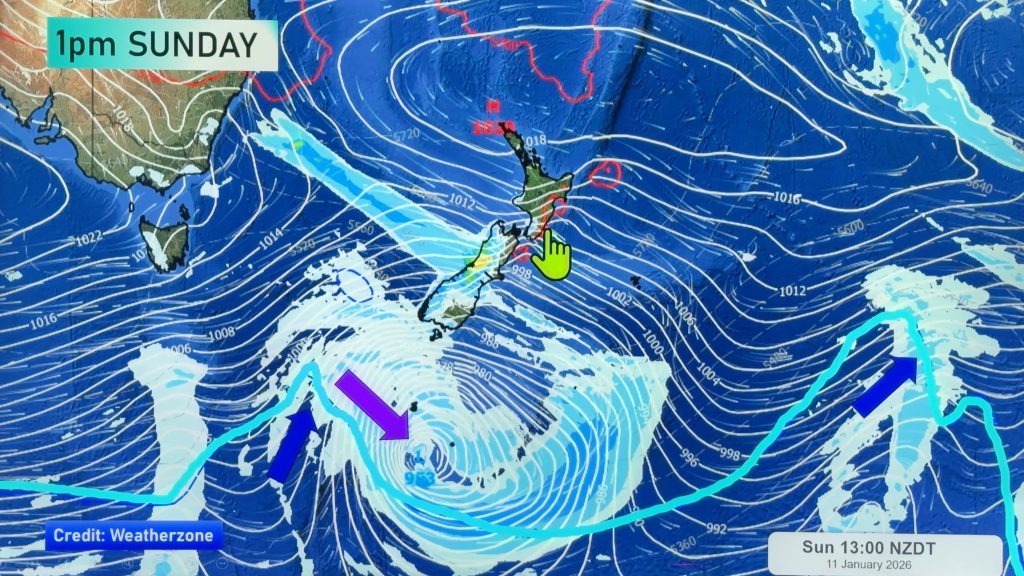UPDATE: State of Emergency declared in Tonga as Cyclone Ula intensifies (+VIDEO)
1/01/2016 7:41pm

> From the WeatherWatch archives
UPDATE: A state of emergency has been declared in Tonga as Tropical Cyclone Ula nears land, bringing with it gusts of up to 200kmh and potential flooding.
Prime Minister ‘Akilisi Pohiva declared a state of emergency for the Vava’u and Ha’apai islands, One News’ correspondent Barbara Dreaver tweeted on Saturday morning.
Power was out in Vava’u and Neiafu, she said.
Tonga’s Fua’amotu Tropical Cyclone Warning Centre had a tropical cyclone warning in place for Vava’u, Ha’apai, Tongatapu and ‘Eua.
It warned of strong winds, heavy rain and damaging swells.
Tropical Cyclone Ula Last Updated: Location: -17.4N 531.4WMovement: SW at 13 mphWind: 165KPHPressure: – pic.twitter.com/s9NIvE60ed
— Alonso Méndez Torres (@AlonsoMendezTor) January 1, 2016
The category three cyclone was moving southwest towards Vava’u on Saturday morning, and was expected to lie about 40km northeast of the island group at 7am.
Winds could be “very destructive”, reaching speeds of up to 120-150kmh in Vava’u, with gusts of up to 200kmh, the centre warned.
Squally thunderstorms and flooding in low-lying areas were expected.
The cyclone had the potential to damage property, crops and infrastructure.
Fiji was bracing for Tropical Cyclone Ula’s arrival after it crossed Tonga, the Fiji Times reported.
Fiji Meteorological Service director Ravind Kumar said Cylcone Ula was not expected to intensify beyond category one, but it might bring welcome rains in the western Pacific which had been suffering from the effects of an El Nino-related drought for months.
SO PACIFIC OCEAN *Full Update* Satellite Captures Birth of South Pacific Tropical Cyclone Ula As Tropical Cyclone… https://t.co/UCuBlsF8yM
— NASAHurricane (@NASAHurricane) December 30, 2015
“At the moment it’s in Samoa. We have a strong wind warning in force for Tuvalu, Tokelau, Kiribati, Cook Islands and Niue,” he told Pacific Beat.
“We are into the wet season as well as into the tropical cyclone season [and] we expect these rains to be coming in.
“To the question of whether it is going to break the dry spell we are experiencing, it is a really relieving rain that we are getting in the islands.”
State of emergency declared for Tongan islands hit by Cyclone Ula. https://t.co/s1oz3jOIkJ pic.twitter.com/0jp3T2E8Xh
— ONE News (@ONENewsNZ) January 1, 2016
Flash flooding warnings were issued for American Samoa as the storm moved south-east.
At its highest point, Tuvalu is just 4.6 metres above sea level.
UNICEF Pacific said that meant the 10,000 people of Tuvalu were on the front line of climate change because they live on low-lying islands without a protective shallow shelf around them.
It said the rising sea level in recent years was putting increasing pressure on communities affected by climate change.
It said Tuvalu continued to be affected by heavy rain, thunderstorms and gale-force storms triggering waves three to four metres high and Disaster Committees on all islands were responding to the alert.
El Nino weather pattern ‘fuel’ for more cyclones
Meteorologists warned warmer ocean water brought on by the El Nino effect meant tropical cyclones would be more prevalent in the Pacific this season.
“During El Nino years, we tend to see more active tropical cyclone seasons, in part because of the warmer water associated with El Nino,” John Bravender, a meteorologist with the Central Pacific Hurricane Centre in Hawaii, said.
“The warm water provides more energy, more heat, more moisture. That’s the fuel for tropical cyclones.”
Mr Kumar said the weather bureau was initially tracking two systems which had merged into Cyclone Ula.
He said the combined system had the potential to bring heavy rains and while the cyclone was unlikely to intensify, it could also bring damaging winds.
“The strong winds can do a lot of damage if the structures are not strong,” Mr Kumar said.
Cyclone Ula passed over Tuvalu as a severe tropical storm, bringing damaging gale-force winds.
In March, at least 24 people were killed in Vanuatu when Cyclone Pam hit the Pacific nation.
– ABC/Weatherzone.com.au/NASA/Stuff
Comments
Before you add a new comment, take note this story was published on 1 Jan 2016.





Add new comment